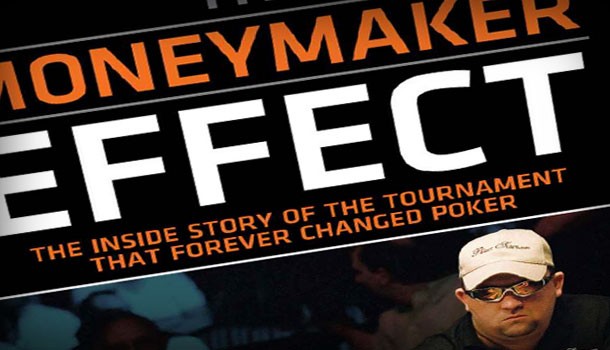
Poker books had a terrific year in 2014.
I was initially pleasantly taken aback by Dutch Boyd’s self-published entry into the world of poker literature. After completing Dutch’s Poker Tilt, I immediately delved into Eric Raskin’s The Moneymaker Effect: The Inside Story of the Tournament That Forever Changed Poker. This book, a continuation and expansion of his 2013 Grantland.com article When We Held Kings, is the best poker article I’ve ever read. In fact, I’ve revisited it several times.
Poker Tilt and The Moneymaker Effect, both instant classics, were inducted into my all-time Top 10 Poker Books list promptly. They stand shoulder to shoulder with Positively Fifth Street, Big Deal, Ghosts at the Table, The Biggest Game in Town, One of a Kind, Titanic Thompson: The Man Who Bet on Everything, The Professor the Banker and the Suicide King, among other outstanding works that I may be unintentionally omitting right now.
A Great Writer + A Great Story = Instant Classic
To clarify in case you haven’t understood, I didn’t just like The Moneymaker Effect, I was completely enamored by it. I quickly read this engaging book in two sittings, eagerly consuming the behind-the-scenes tales of Chris Moneymaker’s 2003 World Series of Poker triumph.
While reading The Moneymaker Effect, I was able to picture the 2003 Main Event ESPN broadcast, which I’ve likely seen dozens of times, materializing on the pages. Additionally, I could clearly remember the hands I haven’t seen in over five years as they unfolded with each page I flipped.
Eric Raskin’s storytelling ability is so powerful that I could vividly imagine the conversations taking place in the hallways of Binions, a place I have never visited, between people I have never met.
Not only is this book a captivating read, but it also holds vital information about poker history. Without Raskin’s documentation of these backstage messages and stories, I believe most of it would have disappeared with time, similar to numerous other poker stories that exist in the ambiguous realm between myth and reality.
Honestly, who would seek out Annie Duke and Howard Lederer in 2014 for their perspectives on the 2003 WSOP?
Before Raskin revealed Moneymaker’s “other” backer, David Gamble, in his Grantland article, who had even heard of this name?
Who would consider it significant enough to locate the producers and A/V personnel from ESPN and 441 Productions?
Who could have predicted not only interviewing Norman Chad and Lon McEachern, but also turning their journey to the 2003 WSOP into an engaging storyline?
Had Raskin not documented the behind-the-scenes events and general sentiment of the poker community during what was arguably the most defining moment in poker history, it would have likely been overlooked. This was indeed the defining poker moment of our era.
T.R.O.Y. (They Reminisce Over You)
The Moneymaker Effect took me on a nostalgic trip back to 2002/2003, a time when poker held a certain innocent allure. This was a period when the poker community was a mere small group of players striving to survive in a ruthless environment. Suddenly, fortune smiled upon them in the form of a golden goose named Moneymaker.
Moneymaker did more than just ignite the Poker Boom; he also served as a link between the intimacy and familiarity of the live poker community before the advent of internet poker, and the global reach and anonymity of online poker.
Sammy Farha was a recognized figure and a member of the inner circle, while Moneymaker was an unfamiliar outsider. However, when the outsider emerged victorious, the landscape of poker was instantaneously transformed.
In the subsequent year, what was once a private party was inundated by thousands of unknown individuals. The year after, thousands more from every part of the world arrived, each with an ambition to become the next Chris Moneymaker.
Having personally experienced that era in the poker world, I believe Raskin and his many interviewees have perfectly encapsulated it all. We were all aware that a significant event had just transpired and that poker was on the verge of transformation. However, none of us foresaw the magnitude of that moment or the extent of the impending change.
As the 2003 WSOP was unfolding, the main topic of discussion on poker forums was about Dutch Boyd and the debt he had incurred from PokerSpot. It was only after Chris Moneymaker’s victory that people began to grasp the significance of what had just happened.
With each subsequent visit to Foxwoods, I encountered an increasing number of unfamiliar faces. Faces that were anonymous, carrying an expression that suggested the sky was the limit.
Prior to 2003, it was unheard of for Limit Holdem and Stud tables to give way to No Limit games in the cash game structure, but I saw it happen.
The realization didn’t occur instantly, but gradually, as if floodgates had been opened, everyone began to understand day by day that we were in the midst of the Poker Boom.
Listening to Raskin and others who were involved in the 2003 WSOP recount their experiences let me revisit that era, which was a significant time for poker players. If you didn’t participate in poker during that time, or if you were influenced by The Moneymaker Effect and the Poker Boom, picking up Eric Raskin’s The Moneymaker Effect will offer you a glimpse into what it was like to experience that period.
The Moneymaker Effect is available for purchase on Amazon.com in both paperback and Kindle format.
For those who understood the T.R.O.Y. reference


